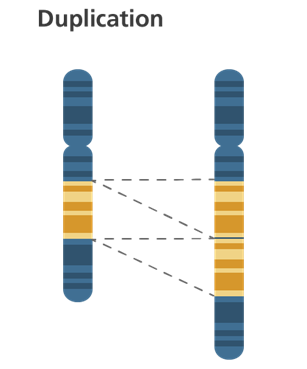Duplications and microduplications
Sections of our genome can be duplicated, resulting in extra genetic material. When a duplication is too small to be seen under a microscope, it is called a microduplication.
What are duplications and microduplications?
Sections of our genome can be duplicated, resulting in extra genetic material. Duplications are a type of copy number variant and can vary in size. If a duplication is too small to be seen under a microscope, it is called a microduplication.
Genetic information is stored in DNA, which is tightly packed into chromosomes. Genes are made up of stretches of DNA. The largest human chromosome (chromosome 1) contains more than 2,000 protein-coding genes and the smallest (chromosome Y) contains just 71.
When a section of a chromosome is duplicated, the genes present in that section will also be duplicated, resulting in extra genetic material. The effect of the duplication on an individual depends on which genes have been duplicated.

Figure 1: A duplication, which results in extra genetic material
From yourgenome, reproduced under Creative Commons Attribution 4.0 International (CC BY 4.0).
Does the size of the duplication matter?
Duplications can vary in size and have a range of effects. The size of the duplication, however, does not necessarily correspond to the size of the effect.
Duplications within genes can be small, but even small changes can alter the amino acid sequence of the resulting protein, which can change its function. Some duplications copy whole genes or chromosomes, resulting in extra protein being produced, which can have dramatic phenotypic consequences. Other duplications have little apparent impact on phenotype.
Use in clinical context
- Genomic testing: While large duplications can sometimes be visualised by a karyotype, a microarray is the gold standard for diagnosing such copy number variants.
- Duplication and microduplication syndromes: Depending on the location of the duplication and the genes involved, there is significant variation in how different syndromes may present. Features that can be found in some duplication and microduplication syndromes include intellectual disability, dysmorphia and congenital anomalies.
Key messages
- Duplications are a type of copy number variant that arise when regions of the genome are duplicated.
- The clinical relevance of duplication and microduplication syndromes depend on the region of DNA that is duplicated and the genes involved.
Resources
For clinicians
- Unique (Understanding Chromosome & Gene Disorders): Duplications and microduplications (PDF, two pages)
For patients
- Unique (Understanding Chromosome & Gene Disorders): Duplications and microduplications (PDF, two pages)